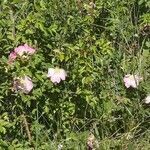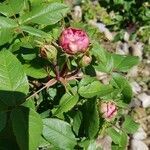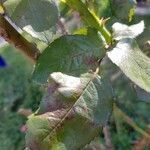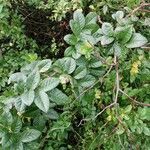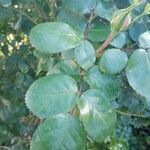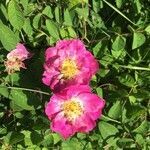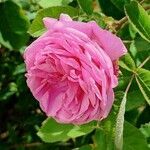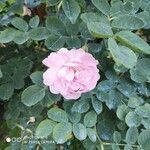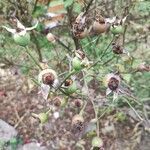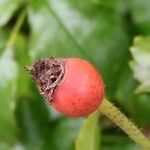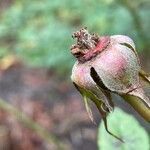Stems: distal branches green to dull red; prickles internodal, curved, sometimes erect, rarely hooked, declined, 3–7 × 2–5 mm. Leaves: stipules subulate, 14–24 × 3–5 mm, auricles 4–10 mm, surfaces pubescent, eglandular; petiole and rachis with sparse pricklets, puberulent, densely stipitate-glandular; leaflets 5(–7), terminal blade slightly rugose, base obtuse to subcordate, margins shallowly 1(–2)-dentate-crenate, teeth 14–23 per side, apex acute to acuminate, abaxial surfaces pale, gray green, sessile-glandular particularly on midveins, adaxial bluish green or dark green. Inflorescences 1–3(–8)-flowered. Pedicels: bracts 1 or 2, caducous, lanceolate, 8–14 × 2–4 mm, margins ciliate, surfaces glabrous or pubescent, eglandular or stipitate-glandular. Flowers: hypanthium 5–7 × 3–5(–7) mm, neck (0–)1 × 3 mm; sepal tip 7 × 2 mm, erect or spreading; petals 27–35 × 20–30 mm [or larger]; styles exsert 2–4 mm beyond hypanthium orifice. Hips leathery. Achenes 3, 5 × 4–5 mm. 2n = 28.
Erect colonial shrub to 1(–1.5) m; stem with stout, hooked prickles and numerous bristles, the latter usually gland-tipped; lf-rachis with scattered short prickles; lfls 3–7, leathery, rugose above, sparsely hairy beneath, 2–6 × 2–3 cm, broadly elliptic to ovate, rounded to subcordate at base; fls mostly solitary at the branch-tips, often double; hypanthium and pedicels glandular-setose; sep deflexed and deciduous after anthesis, the outer usually pinnatifid; pet typically deep pink, (2.5–)3–4.5 cm; 2n=28. Native of Europe, rarely escaped from cult.
A shrub. It loses its leaves during the year.
